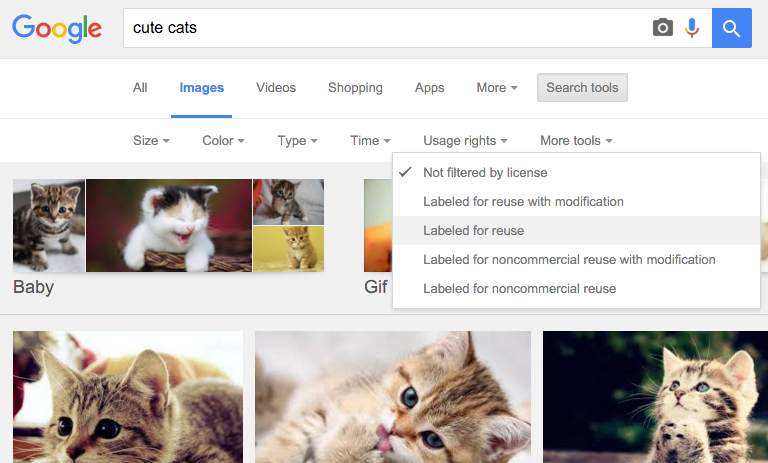Let’s face it—the internet is becoming more and more visual by the minute, which means that we want to fill the blog posts we write with rich, high-quality imagery. Yet many of the images we find online that are perfectly suited for the posts we write are copyrighted. What are you to do in a situation when you find the perfect image online for a blog post, only to find that it also happens to have a copyright license attached to it? While it might be tempting to follow the example of others (and of so many media outlets), infringing copyright law doesn’t become right just because everyone is doing it.
Know how to filter out copyrighted images.
First, let’s go over how to find images that aren’t copyrighted. The easiest way to do this is to do a quick Google Images search for the type of image that you want, and then to filter by license. To do this, you’ll want to hit “Search Tools” below the search bar, followed by “Usage Rights.” This gives you the option of telling Google to give you only images that fit a particular copyright type.
Find the image’s source website and check its usage policy.
Sometimes the source website of the image will detail somewhere on the site just what their image usage policies are. This is especially common with bloggers, who might state somewhere on their site something along the lines of, “You may use one image from a particular blog post, as long as it is linked back to the site.” If you’re lucky enough to find such a policy posted on the website, just be sure that 1) the image does in fact originate from the site, and 2) that you are following the usage policy to a T when you use the image.
Ask the artist.
If you can’t find a usage policy on the website but you can find contact information for the artist, go ahead and contact the artist. Ask, and you just might receive.
Understand the terms “fair use” and “creative commons.”
These terms likely don’t mean what you think that they do. The term “fair use” is highly complex in the world of copyright law, but essentially it means that you can use an artist’s image as long as it is a reasonable use that does not interfere with artist’s right to do with the work as they wish. A classic example of fair use is using an image of a book for a product review. “Creative commons” images are typically licensed and have particular guidelines for use.
Attribution usually isn’t enough.
Many approach using other people’s image with a “shout-out” or “link-back” approach, citing in the caption of the image the name of the artist, or providing a quick link to the image’s source. This does not, however, negate copyright infringement. Sure it might seem like great exposure for the artist, but that reasoning doesn’t trump legality. According to copyright law, the artist ultimately has the power to decide where their work is published.
When in doubt, assume it’s copyrighted.
Most images published after March 1, 1989 don’t require any sort of copyright notice, so really it’s impossible to tell whether or not an image is copyrighted at first glance. Don’t assume it’s copyright-free just because you don’t see a © symbol next to it. This includes making changes to an image—don’t assume that making changes to an image makes it yours. Unfortunately, there really is no substitute for thorough research here.
Long story short: be nice, respect the work of others, and stick to copyright policies precisely when sourcing images. Don’t just assume that because something is posted online, it’s free for everyone to share and use. Just as with person-to-person interaction, the web has an etiquette of its own—whether internet trolls recognize it or not.
